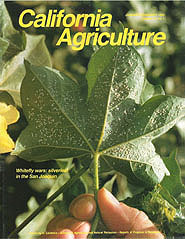


University of California
California Agriculture



|
|||
|
|||

Whitefly wars: silverleaf in the San Joaquin
Cover:
Silverleaf whiteflies cover cotton leaf. Adults transmit viruses as well as feed on sap; they are about 1/16 of an inch long – the width of a nickel. Photo by Tom Perring.
January-February 1993
Volume 47, Number 1 News and opinion |
|||
|
University of California, 1301 S. 46th St., Bldg. 478 Richmond, CA
|